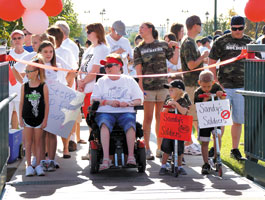The Park at River Walk had its paths full Oct. 1 as hundreds of people walked to raise money for the ALS Association.
“You’re making cutting edge research happen,” said Fred Fisher, president of the Golden West chapter of the ALS Association, as he addressed the crowd at the opening ceremony.
ALS, or amyotrophic lateral sclerosis, is commonly known as Lou Gehrig’s Disease. It’s a neurodegenerative disease that attacks nerve cells in the brain and spinal cord causing paralysis and, ultimately, death.
It is estimated that ALS affects one in every 100,000 people. California alone is home to over 20,000 people with the disease.
The walk and the local branch of the ALS Association were started eight years ago by Michael Gagner and his wife Stacy Inman. Gagner was diagnosed with ALS in 1999 and became frustrated having to drive to the Los Angeles area for support.
“We were wondering why there were no local services,” said Gagner. “It’s very important to have services locally.”
The couple organize the walk every year and are actively involved in patient advocacy despite the fact that Michael is now paralyzed and confined to a motorized wheelchair.
The first ALS walk was held in 2004 and the group began offering assistance to patients in Kern County shortly after.
The event averages between 400 and 500 participants. Walkers organize into teams and often walk in memory of a loved one.
“She was gone in three years. It robbed her of her voice first, which is why we call it Lisa’s Voice,” said Elly Queen about her sister Lisa, who died from the disease. Elly’s team raised almost $2,000 this year.
Team names ranged from serious like Michael’s Miracles to humorous like Neil’s Diamonds.
Funds raised go to help local ALS patients get equipment, fund support grou`ps and get families assistance with paperwork.
Medical equipment is a major concern considering the average estimated cost of having Lou Gehrig’s Disease is $20,000 annually.
“We rent out everything from eating utensils to breathing machines,” said Gagner.
Despite recent medical breakthroughs involving stem cell therapy and local successes, there is still more to be done.
“We’re not doing enough in the area of patient care,” said Fisher.
There are also other areas that need improvement.
“Part of it is education,” said Chuck Dobie, who participates in the walk every year.


